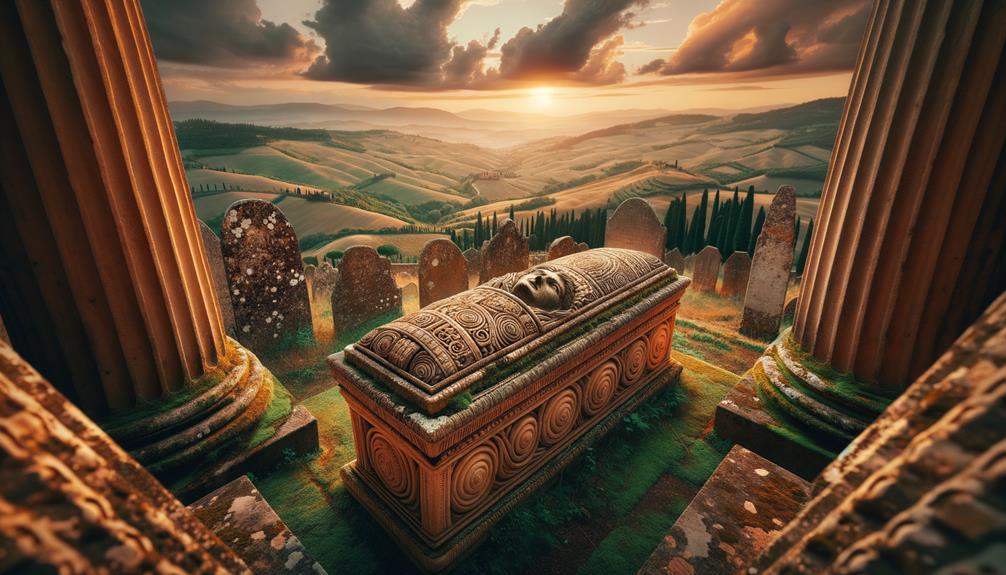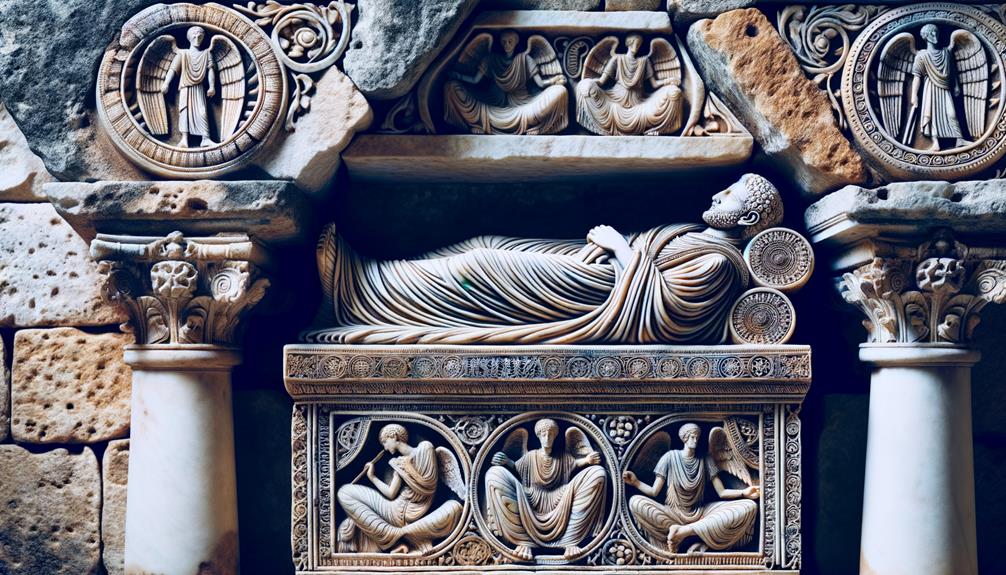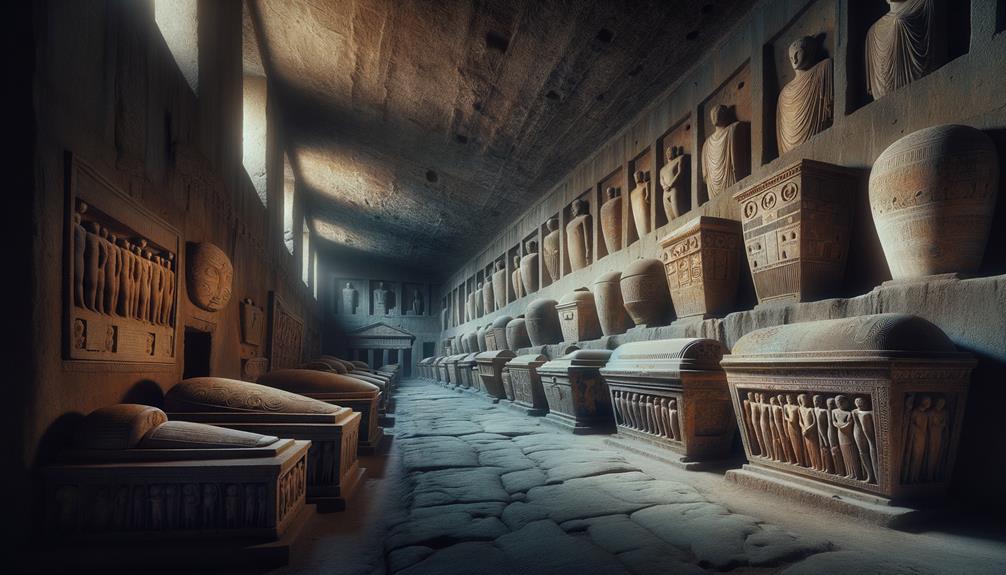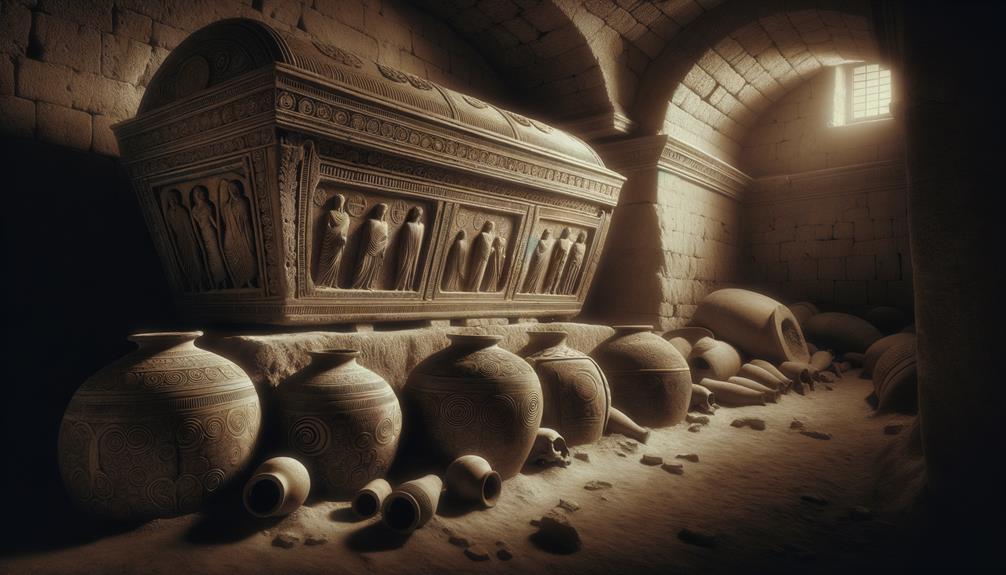The Etruscan sarcophagi and Italian tombs are truly fascinating relics from an era long gone. They give us a glimpse of the artistic prowess and societal customs of the ancient Etruscans. Made from terracotta, these tombs showcase exceptional artistry and a refined sense of design. They are decorated with vibrant colours and detailed carvings that symbolize enduring love, familial bonds, and perspectives on life after death. However, preserving these precious artefacts is a challenge that requires continuous effort. The wealth of knowledge these tombs contain is immense, and as we uncover the layers, we get a rare chance to understand more about this mysterious culture.
Understanding Etruscan Sarcophagi
When you step into the world of Etruscan sarcophagi, you immediately notice these terracotta works of art, often adorned with brightly colored scenes such as feasts. They are more than just tombs; they're a powerful reflection of the Etruscan society's focus on family ties, traditions, and afterlife beliefs. Take the Sarcophagus of the Spouses for instance, it showcases a couple locked in a never-ending hug, a potent symbol of the value they placed on family relationships and the belief in life after death. This lifelike artistry demonstrates the Etruscan's skill at capturing the vitality of life, even in objects meant for those who have passed on. These Etruscan sarcophagi are not only a testament to their artistic gift but also a rich source of information about their societal customs and philosophical thoughts.
Historical Significance of Italian Tombs

If we take a closer look at the historical value of Italian tombs, it's pretty obvious that these final resting spots, particularly the Etruscan sarcophagi, are a gold mine for understanding the artistic and cultural traditions of ancient Italy. These tombs are like silent storytellers of Etruscan culture, acting as windows into their art, social gatherings, family dynamics, and beliefs about life after death. The complexity of their designs also highlights the Etruscans' impressive artistic skills.
So, let's break it down in a nutshell:
| Aspect | What it Tells Us |
|---|---|
| Artistic Tradition | The Etruscan sarcophagi are a mirror to the art of ancient Italy |
| Cultural Practices | The scenes depicted on the tombs provide insights into their social events, family relationships, and beliefs about afterlife |
| Artistic Skills | The detailed designs are a testament to the Etruscans' talent |
Artistic Features of Etruscan Sarcophagi

When you take a look at Etruscan sarcophagi, you can't help but marvel at the detailed carvings, patterns, and inscriptions. They are a testament to the outstanding skills of Etruscan artisans. The terracotta they used, known for its ability to keep colors vibrant, adds an extra dash of charm.
What really catches the eye though are the figures of couples, eternally locked in an embrace. This recurring theme is a powerful symbol of the Etruscan's belief in never-ending love and the importance of family. Not merely decorative, these carvings give us a unique insight into Etruscan funeral traditions and societal norms.
The inscriptions too aren't just for show. They give us a peek into the sophistication of Etruscan society. So, in the end, the Etruscan sarcophagi are more than just containers for the deceased. They are storytellers, weaving together tales of love, death, and culture.
Preservation Challenges and Strategies

Dealing with the relentless ticking clock, Etruscan sarcophagi face a slew of conservation challenges. These range from subtle threats like vibrations to more serious ones like earthquakes, and the continuous wear and tear caused by environmental factors. The National Etruscan Museum is home to these priceless artifacts, and they require constant upkeep by expert restorers.
Methods for conservation are designed to be non-invasive. For instance, X-radiography is used to detect any internal damage to the sarcophagi. Custom-made internal supports and reversible polymers are also employed. These provide long-term stability while ensuring the original artifact isn't compromised.
The crux of these strategies lies in finding a balance. On one hand, we need to safeguard these ancient tombs. On the other, they should be accessible for the public to appreciate and for scholars to study. The task of preserving Etruscan sarcophagi isn't an easy one. It requires a keen eye for detail and a steadfast dedication.
Etruscan Funerary Customs and Beliefs

Deciphering the mysteries of the Etruscan funerary practices is like stepping back in time and getting a firsthand look at this unique and fascinating culture. The Etruscans' views on death, as seen in their tombs and sarcophagi displayed in museums, are quite intriguing. They practiced both cremation and burial, and the method often reflected the individual's social status and wealth.
Family ties were of utmost importance, as seen in the intricate tomb inscriptions that clearly detail familial connections. The scenes of banquets, often featured on sarcophagi, reflect the Etruscans' positive outlook on the afterlife.
What's particularly striking about the Etruscan society is their approach to gender equality, which was rather progressive for the time. Their funerary customs reflect this, as both men and women could be given elaborate burials.
Frequently Asked Questions
What Is the Famous Etruscan Sarcophagus?
So, have you heard about the renowned Etruscan sarcophagus? It's actually called the 'Sarcophagus of the Spouses.' A fascinating find, not so? Discovered in a place called Cerveteri, this magnificent piece showcases a couple, wrapped in what seems to be an everlasting hug. It's a clear representation of the burial traditions and the craftsmanship of the Etruscans, going all the way back to the 6th century BC. Quite a timeless piece, wouldn't you say?
What Is the Famous Etruscan Tomb?
Have you ever heard of the renowned Etruscan tomb known as the Sarcophagus of the Spouses? It's a literal piece of art from the 6th century BC. This remarkable artifact illustrates the timeless love of a couple, frozen in time. It was unearthed in the Banditaccia necropolis, located in the quaint Italian town of Cerveteri.
What Is the Significance of the Etruscan Tombs?
The tombs left behind by the Etruscans offer us a remarkable snapshot into their world. These burial sites are more than just final resting places. They're a visual record of the Etruscans' customs, their family ties, and their wealth. It's not every day you get to take a peek into a civilization that flourished over 2,000 years ago!
Can You Visit Etruscan Tombs?
Absolutely! Etruscan tombs are open for visits. Scattered throughout Italy, especially in places such as Cerveteri and Tarquinia, these tombs offer a unique glimpse into the past. Some have even been recognized as UNESCO World Heritage Sites. As you tour these sites, you will see detailed frescoes, burial chambers, and artifacts, all of which provide a fascinating insight into Etruscan burial customs.


